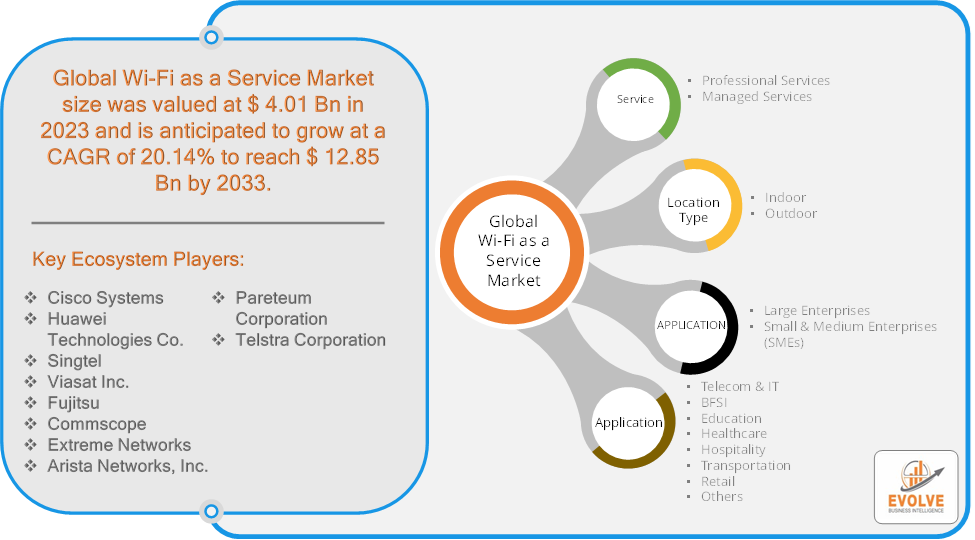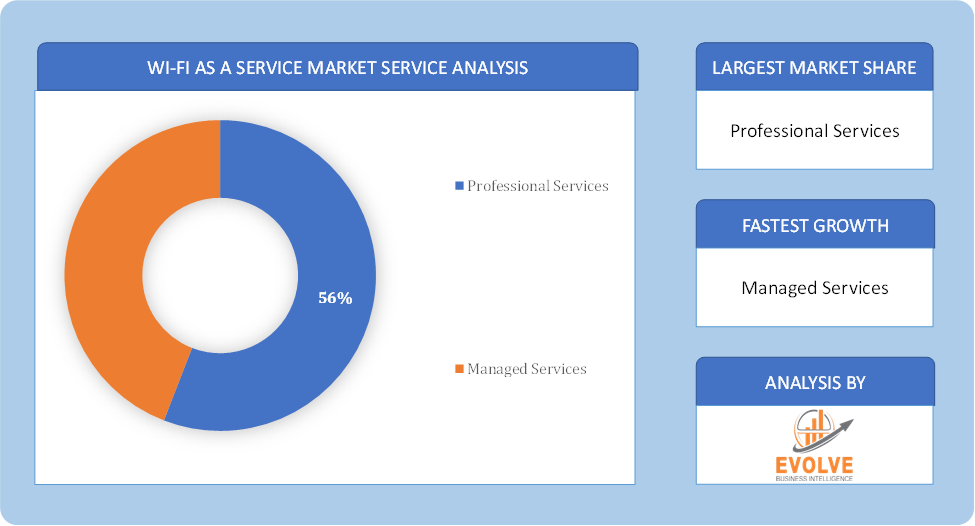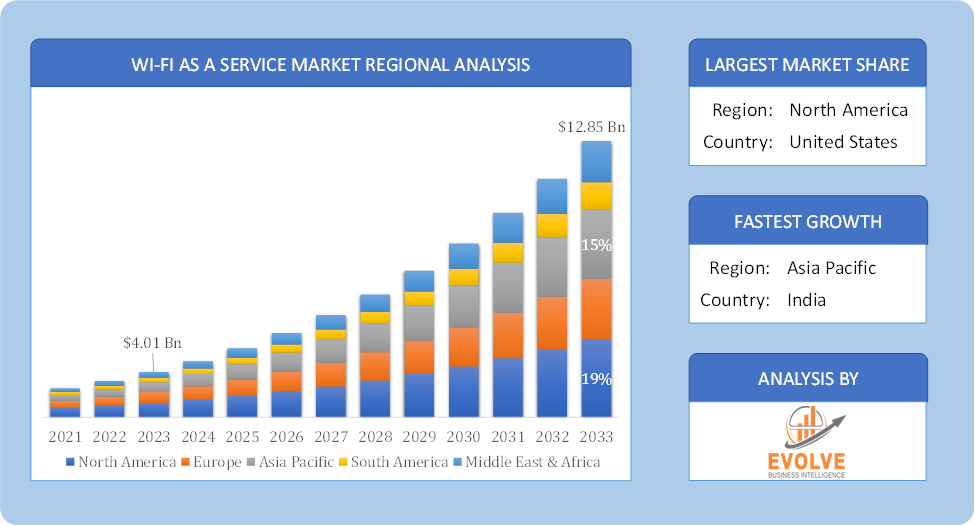Wi-Fi as a Service Market Overview
The Wi-Fi as a Service Market Size is expected to reach USD 12.85 Billion by 2033. The Wi-Fi as a Service Market industry size accounted for USD 4.01 Billion in 2023 and is expected to expand at a compound annual growth rate (CAGR) of 20.14% from 2023 to 2033. Wi-Fi as a Service (WaaS) is a business model where a third-party provider manages and delivers Wi-Fi connectivity to businesses and organizations. Instead of purchasing and maintaining their own Wi-Fi infrastructure, these entities subscribe to a WaaS service, allowing them to focus on their core operations.
WaaS is popular among businesses, educational institutions, healthcare facilities, and other organizations looking for scalable and cost-effective Wi-Fi solutions without the complexities of managing the infrastructure themselves. It often includes features like security updates, scalability, and integration with other IT services.
Global Wi-Fi as a Service Market Synopsis
The COVID-19 pandemic had a significant impact on the Wi-Fi as a Service (WaaS) market. With the shift to remote work and online education during lockdowns, there was a surge in demand for reliable and scalable Wi-Fi solutions. This drove interest in WaaS, as organizations sought to quickly and efficiently enhance their network capabilities to support remote activities. The pandemic accelerated the adoption of cloud-based services, including WaaS. Businesses and educational institutions favored cloud-managed Wi-Fi solutions for their flexibility and ease of deployment, which allowed them to adapt to rapidly changing conditions. With more employees and students accessing networks from various locations, there was an increased emphasis on network security. WaaS providers responded by enhancing their security features and offering more robust protection against cyber threats. The pandemic accelerated the broader digital transformation trend, including the adoption of WaaS. Organizations were motivated to modernize their IT infrastructure, which included upgrading or implementing managed Wi-Fi solutions.
Wi-Fi as a Service Market Dynamics
The major factors that have impacted the growth of Wi-Fi as a Service Market are as follows:
Drivers:
Ø Growth in Remote and Hybrid Work
As remote and hybrid work models become more common, organizations require flexible and scalable Wi-Fi solutions to support a distributed workforce and ensure seamless connectivity. The broader shift towards cloud-based services and infrastructure supports the growth of WaaS. Businesses prefer cloud-managed Wi-Fi for its ease of deployment, management, and scalability. Enhanced security features and ongoing updates provided by WaaS solutions address growing concerns about cybersecurity and data protection, making WaaS an attractive option for organizations. WaaS simplifies network management by outsourcing tasks such as maintenance, troubleshooting, and updates to service providers, allowing organizations to focus on their core activities.
Restraint:
- Perception of High Initial Setup Costs and Data Privacy Issues
Although WaaS generally offers cost savings over time, the initial setup and subscription fees can be high, particularly for smaller organizations or those with limited budgets. The handling of sensitive data by WaaS providers raises concerns about data privacy and compliance with regulations like GDPR. Organizations need to ensure that providers adhere to strict data protection standards.
Opportunity:
⮚ Rising Demand for Smart Cities
As cities become smarter with the integration of IoT and connected devices, there is increasing demand for robust, scalable, and reliable Wi-Fi infrastructure. WaaS can play a crucial role in supporting these smart city initiatives. With the rise of digital learning and remote education, schools and universities require enhanced network infrastructure. WaaS can offer cost-effective and scalable solutions to support online learning and campus-wide connectivity. The retail and hospitality industries are focusing on enhancing customer experiences through digital services and connected technologies. WaaS can provide the necessary infrastructure to support guest Wi-Fi, digital signage, and other connected services.
Wi-Fi as a Service Market Segment Overview
Based on Service, the market is segmented based on Professional Services and Managed Services. The professional services segment dominant the market. Professional Services encompass a wide range of expertise and support that service providers offer to businesses implementing WaaS solutions. These services include consulting, network design, installation, configuration, maintenance, and ongoing technical support. Service providers fill the gap by offering specialized knowledge and experience in designing customized WiFi solutions tailored to the specific needs of the business. This includes conducting site surveys, analyzing network requirements, and determining the optimal placement of access points. Moreover, the installation and configuration of WiFi networks can be complex, requiring technical skills and domain expertise.
By Location Type
Based on Location Type, the market segment has been divided into Indoor and Outdoor. The outdoor segment dominant the market. Outdoor WiFi networks enable seamless internet access for individuals, whether they are working remotely, attending events, or simply seeking connectivity while on the go. The growing popularity of smart devices and the need for constant connectivity have further fueled the demand for outdoor WiFi solutions. Moreover, outdoor WiFi networks play a crucial role in supporting smart city initiatives and enhancing public services.
By Application
Based on Application, the market segment has been divided into Large Enterprises and Small & Medium Enterprises (SMEs). The Large enterprises segment dominant the market. These organizations require robust and scalable WiFi networks to support a large number of employees accessing critical applications, collaborating on projects, and utilizing cloud-based services. WiFi as a Service offers large enterprises the flexibility to expand their network capacity and coverage as their workforce grows or as they open new locations.
By End User
Based on End Users, the market segment has been divided into Telecom & IT, BFSI, Education, Healthcare, Hospitality, Transportation, Retail and Others. The healthcare category dominated the market. Wi-Fi connectivity is crucial in healthcare settings to support electronic health records, telemedicine, medical device connectivity, and patient monitoring. WaaS in healthcare enables seamless communication between Medical staff, efficient data exchange, and improved patient care.
Global Wi-Fi as a Service Market Regional Analysis
Based on region, the global Wi-Fi as a Service Market has been divided into North America, Europe, Asia-Pacific, the Middle East & Africa, and Latin America. North America is projected to dominate the use of the Wi-Fi as a Service Market followed by the Asia-Pacific and Europe regions.
 Wi-Fi as a Service North America Market
Wi-Fi as a Service North America Market
North America holds a dominant position in the Wi-Fi as a Service Market. North America is a mature market for WaaS, with established players and a high level of technological adoption. The region is witnessing a strong demand for WaaS solutions in enterprise networks and public spaces like airports and hotels and strong demand from enterprises, educational institutions, and healthcare facilities and have High focus on cloud solutions and advanced network management.
Wi-Fi as a Service Asia-Pacific Market
The Asia-Pacific region has indeed emerged as the fastest-growing market for the Wi-Fi as a Service Market industry. The Asia-Pacific region is witnessing explosive growth in the WaaS market, fueled by rapid urbanization, economic development, and increasing internet penetration. Countries like India, China, and Indonesia are experiencing significant growth in the WaaS market as businesses and consumers seek reliable and affordable connectivity and Rapid urbanization, expanding economies, and a growing middle class driving demand for enhanced connectivity.
Competitive Landscape
The global Wi-Fi as a Service Market is highly competitive, with numerous players offering a wide range of software solutions. The competitive landscape is characterized by the presence of established companies, as well as emerging startups and niche players. To increase their market position and attract a wide consumer base, the businesses are employing various strategies, such as product launches, and strategic alliances.
Prominent Players:
- Cisco Systems
- Huawei Technologies Co.
- Singtel
- Viasat Inc.
- Fujitsu
- Commscope
- Extreme Networks
- Arista Networks, Inc.
- Pareteum Corporation
- Telstra Corporation
Key Development
In June 2023, Cisco Systems Inc. launched the powerful generative AI technology “Webex” which allows users to quickly catch up on missed interactions, including meetings, calling, chats and more.
In February 2023, Fortinet Inc. launched the Fifth-generation security processing unit (FortiSP5) to accelerate the convergence of networking and security across every network edge. It delivers unparalleled levels of power-efficient performance to open new frontiers for securing the branch, campus, 5G, edge compute, and operational technologies.
Scope of the Report
Global Wi-Fi as a Service Market, by Service
- Professional Services
- Managed Services
Global Wi-Fi as a Service Market, by Location Type
- Indoor
- Outdoor
Global Wi-Fi as a Service Market, by Application
- Large Enterprises
- Small & Medium Enterprises (SMEs)
Global Wi-Fi as a Service Market, by End User
- Telecom & IT
- BFSI
- Education
- Healthcare
- Hospitality
- Transportation
- Retail
- Others
Global Wi-Fi as a Service Market, by Region
- North America
- US
- Canada
- Mexico
- Europe
- UK
- Germany
- France
- Italy
- Spain
- Benelux
- Nordic
- Rest of Europe
- Asia Pacific
- China
- Japan
- South Korea
- Indonesia
- Austalia
- Malaysia
- India
- Rest of Asia Pacific
- South America
- Brazil
- Argentina
- Rest of South America
- Middle East & Africa
- Saudi Arabia
- UAE
- Egypt
- South Africa
- Rest of Middle East & Africa
| Parameters | Indicators |
|---|---|
| Market Size | 2033: USD 12.85 Billion |
| CAGR (2023-2033) | 20.14% |
| Base year | 2022 |
| Forecast Period | 2023-2033 |
| Historical Data | 2021 (2017 to 2020 On Demand) |
| Report Coverage | Revenue Forecast, Competitive Landscape, Growth Factors, and Trends |
| Key Segmentations | Service, Location Type, Application and End User |
| Geographies Covered | North America, Europe, Asia-Pacific, South America, Middle East, Africa |
| Key Vendors | Cisco Systems, Huawei Technologies Co., Singtel, Viasat Inc., Fujitsu, Commscope, Extreme Networks, Arista Networks, Inc., Pareteum Corporation and Telstra Corporation |
| Key Market Opportunities | · Rising Demand for Smart Cities · Educational Institutions |
| Key Market Drivers | · Growth in Remote and Hybrid Work · Cloud Adoption and Focus on Network Security |
REPORT CONTENT BRIEF:
- High-level analysis of the current and future Wi-Fi as a Service Market trends and opportunities
- Detailed analysis of current market drivers, restraining factors, and opportunities in the future
- Wi-Fi as a Service Market historical market size for the year 2021, and forecast from 2023 to 2033
- Wi-Fi as a Service Market share analysis at each product level
- Competitor analysis with detailed insight into its product segment, Government & Defense strength, and strategies adopted.
- Identifies key strategies adopted including product launches and developments, mergers and acquisitions, joint ventures, collaborations, and partnerships as well as funding taken and investment done, among others.
- To identify and understand the various factors involved in the global Wi-Fi as a Service Market affected by the pandemic
- To provide a detailed insight into the major companies operating in the market. The profiling will include the Government & Defense health of the company’s past 2-3 years with segmental and regional revenue breakup, product offering, recent developments, SWOT analysis, and key strategies.








